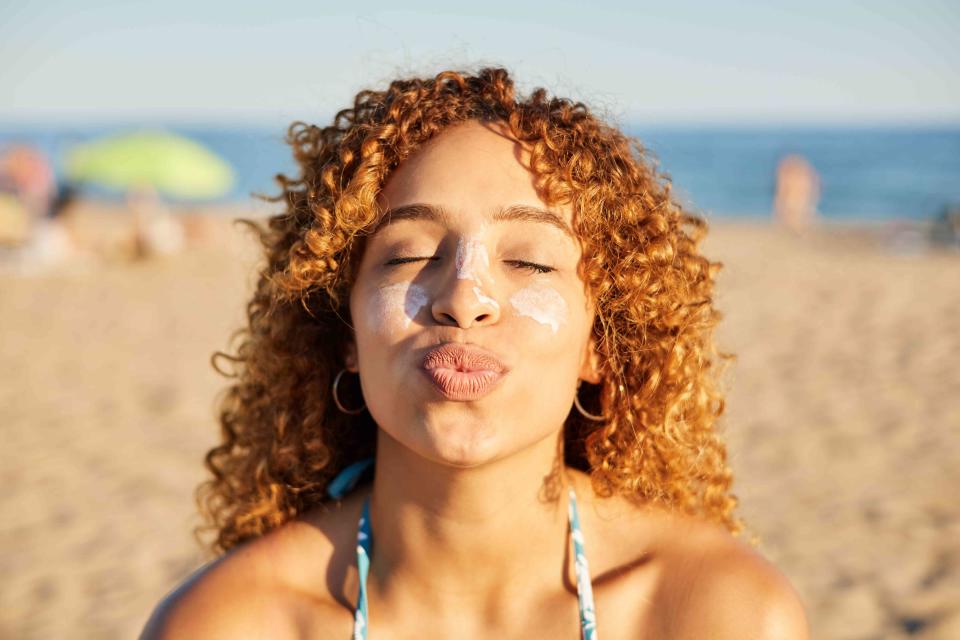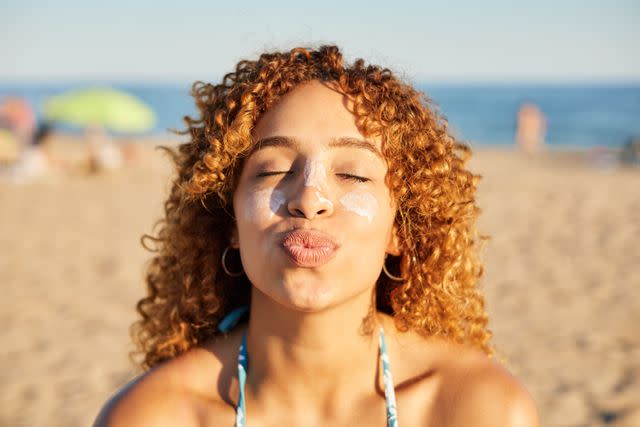Does Sunscreen Prevent Tanning? Here's What a Dermatologist Has to Say
PSA: There’s no such thing as a safe tan.

Javier Sanz/Getty Images
Fact checked by Haley Mades
Summer means longer days and lots more time spent outside enjoying great weather, al fresco dining, and a bevy of recreational activities. That said, you’ve probably noticed that you tend to get a little more tan throughout summer months—even if you’re applying sunscreen to your face and body before heading out the door.
“Increased exposure to sunlight leads to higher levels of UV radiation reaching the skin. This stimulates the production of melanin, which is the pigment responsible for skin color,” explains Heather D. Rogers, MD, a board-certified dermatologist and founder of Doctor Rogers Skin Care. An uptick in melanin production translates to tan.
We know what you’re thinking. Isn’t sunscreen supposed to prevent tanning and burns? The answer is yes, but tanning can still occur for a few different reasons.

Javier Sanz/Getty Images
Why You Can Still Tan While Wearing SPF
Here’s the deal: When sunscreen is applied correctly and re-applied every two hours or after getting wet, it significantly reduces your chance of getting a tan or burn.
“Sunscreen works by blocking (if it's a mineral sunscreen) or absorbing (if it's a chemical sunscreen) UV radiation, which is responsible for tanning and burning,” Dr. Rogers explains. “However, no sunscreen provides 100% protection, and some UV radiation can still penetrate through sunscreen.”
In other words, while proper sunscreen use dramatically reduces the likelihood of sun damage, it's not entirely foolproof. This is where things like sun-protective clothing, hats, sunglasses, and sticking to shady spots can help reduce your overall exposure.
If you notice you’re still getting a decent tan even when slathering SPF, consider these culprits:
Poor Application: User error is a common reason people get tan or burnt even when wearing sunscreen. “It's crucial to apply an adequate amount of sunscreen to achieve the stated SPF protection,” Dr. Rogers says. She recommends using about two tablespoons worth to cover your body, including your face, ears, neck, feet, and scalp.
Inadequate Re-Application: Sunscreen should be reapplied every two hours or more frequently if you're sweating or swimming.
Low SPF: Not all sunscreens are created equally! Make sure you're using a broad-spectrum sunscreen, which means it protects against both UVA and UVB rays. Most sunscreens these days are broad-spectrum, but always double-check. Also, stick to an SPF of 30 or higher.
Old Sunscreen: Yep, sunscreen expires! And you want to make sure you’re not using any product beyond its “best by” date.
Mixed Products: Sunscreen doesn’t always play nicely with other ingredients. Avoid layering two silicone products on top of each other (which can cause pilling), layering SPF over an oil, or mixing your SPF with lotions, oils, or foundations.
You’re Spending a Lot of Time in the Sun: Remember, even the best SPF isn’t 100% effective in shielding you against the sun’s UV rays. Wear hats, carry a sun umbrella, seek shade, and try to avoid peak sunlight hours when possible.
Why Tans Are Never a Good Idea
No matter what you’ve been told about “base tans” or how good you look with that golden glow, there’s no such thing as a safe tan.
The critical point to remember is that even when your skin appears to be tanning and not burning, DNA changes are silently taking place within your skin cells. “The skin tans in response to damage to cell DNA caused by UV radiation from the sun or tanning beds,” Dr. Rogers says. “Even if you're not experiencing visible burning, tanning indicates the skin has been damaged because the skin makes pigment in response to that damage to try and better protect itself from further damage.”
She adds that cumulative skin damage is harmful for all skin types. It leads to premature aging—including wrinkles, sunspots, and skin laxity—but more importantly increases your risk of developing skin cancer.
If you love that summertime glow, consider a professional spray tan, a sunless tanner product you can use at home, a tinted sunscreen that lends a bit more glow, and/or bronzers.
For more Real Simple news, make sure to sign up for our newsletter!
Read the original article on Real Simple.

